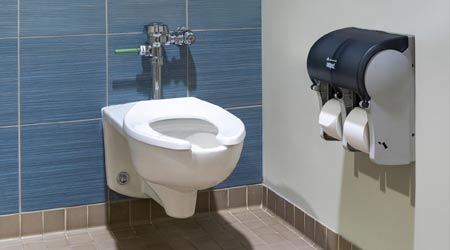view all Case Studies
(Not) Making a Splash: Flushometer Solves Hospital's Problem

Hospitals are often among the cleanest places there are, but Rush University Medical Center in Chicago recently found that a few small changes to its plumbing fixtures could make cleaning a little easier.
August 1, 2016 -
Plumbing & Restrooms
Hospitals are often among the cleanest places there are, but Rush University Medical Center in Chicago recently found that a few small changes to its plumbing fixtures could make cleaning a little easier.
On its nursing floors, Rush provided its nursing staff with bedpan washers to clean the bedpans after use. Sounds hygienic enough — until the staff found that the washers could splash and soil their scrubs, resulting in displeased staff and concern over the spread of bacteria.
Working together, Rush’s plumbing engineer and Sloan’s representative came up with the idea to try using a Sloan Uppercut dual-flush flushometer to not only reduce the splashing by the bedpan washer but to save water, as well.
The dual-flush handle offers users two flush options. They can tilt the handle up to flush with 1.1 gallons per flush (gpf) of water, or they can push it down for a standard 1.6 gpf flush. Sloan's Uppercut dual-flush technology is available as part of a complete flushometer or in handle retrofit kits for converting existing manual flushometers to water-efficient, dual-flush capability.
The team conducted a test of the dual-flush handle on part of the floor and compared it to the other bedpan washers. Feedback from the nursing director was positive. The dual handles reduced the splashing. As a result, Rush has created a program to systematically replace all handles throughout the facility with Sloan Uppercut dual-flush flushometers.
Ever the research institution, Rush University Medical Center conducted experiments in a pursuit to find the best faucet for their staff and patients. The hospital installed multiple faucet types throughout the building and placed a suggestion box next to each one. After many days and hundreds of comments, Rush selected the Sloan EAF 225 hardwired, deck-mounted infrared faucet with illuminated temperature indicator.
Their reasons for choosing the EAF faucet were many:
• Users liked the above-deck side mixer that enables them to adjust the water temperature and see how hot the water will be with an illuminated temperature indicator ring.
• The faucet saves water through its 1.5 gpm flow rate and automatic water shutoff after one minute of continuous water flow.
• The faucet has a laminar water flow, which is recommended for hospitals, senior care facilities, and medical labs. Regular faucet aerators draw air in from the room and mix it with water in the mixing chamber. The problem is that room air often can contain harmful bacteria, such as Legionnaire’s disease, which could contaminate the water when mixed with water. Laminar devices do not draw air into the water stream and produce a non-aerated crystal clear stream of 100 percent water. With the EAF faucet, the problem is solved.
“We have been very pleased with the Sloan products,” says Reubin Cantu, mechanical systems manager at Rush University Medical Center. “The Uppercut dual-flush flushometers met all of our needs for eliminating the bedpan splashing issue. And the EAF faucets enable hygienic, touch-free handwashing. The water temperature adjustment, laminar flow and water savings features were additional benefits that really made the Sloan faucets the obvious choice.”
Next
Read next on FacilitiesNet












